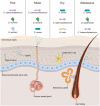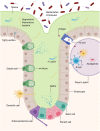The Skin and Intestinal Microbiota and Their Specific Innate Immune Systems
- PMID: 31921196
- PMCID: PMC6928192
- DOI: 10.3389/fimmu.2019.02950
The Skin and Intestinal Microbiota and Their Specific Innate Immune Systems
Abstract
The skin and intestine are active organs of the immune system that are constantly exposed to the outside environment. They support diverse microbiota, both commensal and pathogenic, which encompass bacteria, viruses, fungi, and parasites. The skin and intestine must maintain homeostasis with the diversity of commensal organisms present on epithelial surfaces. Here we review the current literature pertaining to epithelial barrier formation, microbial composition, and the complex regulatory mechanisms governing the interaction between the innate immune system and microbiota in the skin and intestine. We also compare and contrast the skin and intestine-two different organ systems responsible creating a protective barrier against the external environment, each of which has unique mechanisms for interaction with commensal populations and host repair.
Keywords: AMPs; innate immunity; intestine; microbiome; skin.
Copyright © 2019 Coates, Lee, Norton and MacLeod.
Figures


References
-
- Marks J, Miller J. Lookingbill and Marks' Principles of Dermatology. 6th ed Elsevier; (2017).
Publication types
MeSH terms
Grants and funding
LinkOut - more resources
Full Text Sources
Medical

